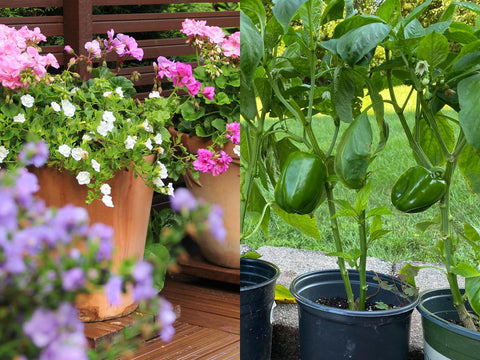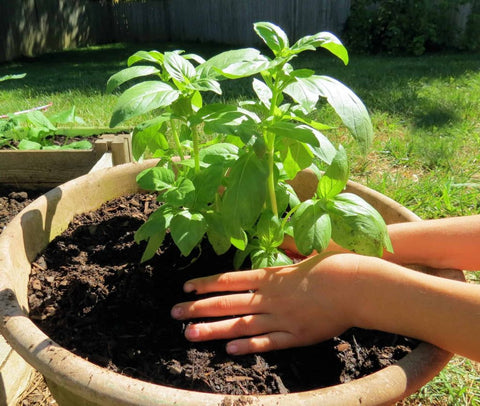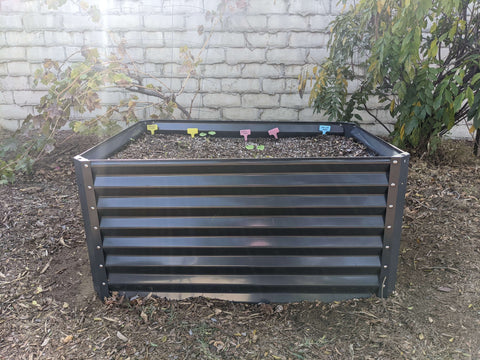Gardening is a timeless passion, but it's not always limited to vast outdoor spaces. Whether you have a tiny balcony, a small patio, or even just a sunny windowsill, you can create a flourishing garden in containers. Container gardening offers the flexibility to grow a wide variety of plants, from delectable edibles to beautiful ornamentals, all within the limited space of pots and containers. In this extensive blog post, we'll explore the art of container gardening, sharing tips, techniques, and inspiration for turning your small outdoor or indoor space into a green paradise.

The Allure of Container Gardening
Container gardening has captured the hearts of both seasoned gardeners and newcomers to the world of horticulture for several compelling reasons:
1. Limited Space Solution
Container gardening is a perfect solution for individuals living in urban environments or homes with minimal outdoor space. It allows you to maximize the use of balconies, patios, rooftops, and even windowsills.
2. Accessibility
Containers can be placed at a convenient height, making gardening accessible to people with mobility issues or those who prefer not to bend or kneel.
3. Design Freedom
Container gardening offers endless possibilities for creativity. You can design and rearrange your garden as often as you like, experimenting with different plant combinations and arrangements.
4. Pest Control
Container gardens are less susceptible to pests and diseases compared to traditional in-ground gardens. You have better control over the environment, reducing the risk of infestations.
5. Mobility
Containers are portable, allowing you to move your garden around to optimize sunlight, protect plants from extreme weather, or simply change your outdoor scenery.
Choosing the Right Containers
Before you embark on your container gardening journey, it's essential to select the right containers. Here are some factors to consider:
1. Size
Choose containers that provide enough space for the plants you want to grow. Larger containers retain moisture better and allow for deeper root systems. Smaller pots are suitable for herbs and compact ornamentals.
2. Material
Containers come in various materials, including terracotta, ceramic, plastic, metal, and wood. Each material has its advantages and drawbacks. For example, terracotta pots are porous and offer excellent drainage, but they dry out quickly. Plastic containers are lightweight and retain moisture better but may not have the same aesthetic appeal as ceramic or terracotta.
3. Drainage
Proper drainage is crucial to prevent waterlogged soil, which can lead to root rot. Ensure that your containers have drainage holes at the bottom. Elevating the pots slightly using pot feet or placing a layer of gravel at the bottom can further enhance drainage.
4. Aesthetics
Consider the overall look you want to achieve with your container garden. The design and style of your containers should complement the plants and the space they'll inhabit.
5. Mobility
If you plan to move your containers frequently, choose lightweight pots with handles or wheels for easy transport.

Selecting the Right Plants
Container gardening opens up a world of possibilities for plant selection. Here are some popular categories of plants to consider:
1. Herbs
Herbs are among the most straightforward and rewarding plants to grow in containers. Basil, rosemary, mint, parsley, and thyme thrive in pots and can be used fresh in your culinary adventures.
2. Vegetables
Many vegetables are well-suited for container gardening. Tomatoes, peppers, lettuce, carrots, and radishes can all be grown in containers, providing you with homegrown produce.
3. Flowers
Ornamental flowers add color and vibrancy to your container garden. Consider petunias, marigolds, geraniums, or pansies for a burst of floral beauty.
4. Small Fruits
Certain fruiting plants, like strawberries and blueberries, are compact enough to thrive in containers. Enjoy the sweetness of homegrown berries, even in limited spaces.
5. Succulents and Cacti
For those with a penchant for low-maintenance plants, succulents and cacti are excellent choices. They thrive in containers and require minimal attention.
6. Dwarf Trees and Shrubs
Some dwarf tree and shrub varieties, such as dwarf citrus trees or miniature roses, are ideal for container gardening. They can add structure and elegance to your garden.
Container Gardening Techniques
Successful container gardening requires attention to several essential techniques:
1. Soil Selection
Use a high-quality potting mix designed especially for container gardening. Potting mixes are lightweight, well-draining, and contain essential nutrients. Avoid using garden soil, as it may not provide adequate drainage.
2. Watering
Containers can easily dry up, especially during warmer weather. Check the moisture level of the soil regularly by inserting your finger about an inch deep. Water thoroughly when the soil feels dry. Be cautious not to overwater, as this can lead to root rot.
3. Fertilizing
Container plants rely on you for their nutrients. Use a balanced, slow-release fertilizer or a liquid fertilizer according to the plant's specific needs. Follow the recommended feeding schedule for optimal growth.
4. Sunlight
Most container plants thrive in full sun, which typically means at least six hours of direct sunlight per day. However, some shade-loving plants can flourish in partially shaded areas.
5. Soil Depth
Different plants require varying depths of soil for their root systems. Ensure that your containers are deep enough to accommodate the root growth of the plants you choose. For example, tomatoes need deeper pots than herbs.
6. Pruning and Deadheading
Regularly prune and deadhead your plants to encourage healthy growth and prevent overcrowding. Removing spent blooms and excessive foliage promotes better air circulation and reduces the risk of disease.
7. Pests and Diseases
Monitor your container garden for signs of pests or diseases. Early detection allows for prompt treatment. Consider using natural pest control methods to protect your plants.

List of 10 Edibles and Ornamentals for Container Gardening
Now that we've covered the essential aspects of container gardening, let's explore some list of edibles and ornamentals that you can successfully grow in containers:
Edibles:
- Tomatoes: Compact varieties like "Patio" or "Tiny Tim" are perfect for containers. Provide support for the vines with stakes or cages.
- Basil: This aromatic herb thrives in pots and can be used fresh in salads, pasta dishes, and pesto.
- Strawberries: Choose a strawberry pot or hanging basket to grow these sweet berries. They can be both ornamental and delicious.
- Lettuce: Leafy greens like lettuce and spinach are ideal for shallow containers. Harvest the leaves for fresh salads.
- Chives: Chives are easy to grow and add a mild onion flavor to your dishes. They produce lovely purple flowers in the spring.
- Dwarf Lemon Tree: If you have a sunny spot indoors, consider a dwarf lemon tree. You can enjoy homegrown lemons year-round.
- Peppers: Bell peppers and chili peppers thrive in containers. They add a spicy kick to your culinary creations.
- Radishes: Radishes are quick-growing and don't require deep pots. They're perfect for beginners.
- Mint: Mint is a vigorous herb that's best contained in a pot to prevent it from taking over your garden.
- Parsley: This versatile herb can be used as a garnish or a key ingredient in various dishes. It grows well in containers.
- Rosemary: This aromatic herb thrives in containers and adds a savory flavor to roasted dishes.
Ornamentals:
- Geraniums: These vibrant flowering plants come in a variety of colors and are well-suited for containers.
- Petunias: Petunias are known for their stunning trumpet-shaped flowers and make for beautiful container displays.
- Marigolds: Marigolds add a burst of color and are excellent companion plants for repelling pests.
- Pansies: Pansies are cool-season annuals with charming, colorful faces that brighten up your garden.
- Dwarf Roses: Miniature rose varieties are perfect for containers, offering the elegance of roses in a compact form.
- Lavender: This fragrant herb not only looks beautiful but also attracts pollinators to your garden.
- Calibrachoa: Also known as million bells, these trailing flowers create a cascading effect in hanging baskets.
- Snapdragons: These tall and colorful flowers add vertical interest to your container garden.
- Coleus: Coleus plants come in a stunning array of colors and patterns, making them a striking addition to your containers.
- Ferns: Ferns are great for adding texture and a touch of greenery to shaded areas.
- Dwarf Hydrangeas: Compact hydrangea varieties thrive in pots and offer clusters of beautiful flowers.
- Dwarf Sunflowers: Enjoy the cheerful presence of sunflowers on a smaller scale with dwarf varieties perfect for containers.

Container Garden Design Inspiration
As you embark on your container gardening adventure, draw inspiration from various garden design ideas:
1. Vertical Gardens
Maximize space by using vertical planters, shelves, or trellises to create a lush green wall of plants.
2. Color Themes
Choose plants with complementary colors to create harmonious container arrangements. For example, combine purple petunias with white alyssum for a striking contrast.
3. Herb Towers
Stack multiple containers of different sizes to create an herb tower. Plant different herbs on each level for a functional and visually appealing garden.
4. Succulent Gardens
Succulents come in a variety of shapes and sizes. Create eye-catching succulent gardens in containers of different shapes and textures.
5. Seasonal Displays
Change your container garden with the seasons. Plant spring bulbs for a burst of color, followed by summer annuals and fall mums.
Conclusion: Cultivate Your Container Garden Oasis
Container gardening allows you to bring the joys of gardening into even the smallest of spaces. Whether you're growing fresh herbs for your culinary endeavors, harvesting homegrown vegetables, or simply beautifying your outdoor area with colorful flowers, container gardening offers a world of possibilities. With the right containers, soil, and techniques, you can create a thriving oasis of greenery and color.
So, whether you're a seasoned gardener or a beginner with a green thumb, start your container garden journey today. Experiment with different plants, designs, and arrangements to create a magical garden in pots that brightens your home and brings nature closer to your daily life. Happy gardening!









